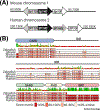The Speckled Protein (SP) Family: Immunity's Chromatin Readers
- PMID: 32386862
- PMCID: PMC8327362
- DOI: 10.1016/j.it.2020.04.007
The Speckled Protein (SP) Family: Immunity's Chromatin Readers
Abstract
Chromatin 'readers' are central interpreters of the epigenome that facilitate cell-specific transcriptional programs and are therapeutic targets in cancer and inflammation. The Speckled Protein (SP) family of chromatin 'readers' in humans consists of SP100, SP110, SP140, and SP140L. SPs possess functional domains (SAND, PHD, bromodomain) that dock to DNA or post-translationally modified histones and a caspase activation and recruitment domain (CARD) to promote multimerization. Mutations within immune expressed SPs associate with numerous immunological diseases including Crohn's disease, multiple sclerosis, chronic lymphocytic leukemia, veno-occlusive disease with immunodeficiency, as well as Mycobacterium tuberculosis infection, underscoring their importance in immune regulation. In this review, we posit that SPs are central chromatin regulators of gene silencing that establish immune cell identity and function.
Keywords: Aire; B cells; CLL; Crohn’s disease; Mycobacterium tuberculosis; PML nuclear bodies; SP100; SP110; SP140; SP140L; VODI; chromatin; epigenetics; macrophages; multiple sclerosis.
Copyright © 2020 The Author(s). Published by Elsevier Ltd.. All rights reserved.
Figures






References
-
- Szostecki C. et al. (1990) Isolation and characterization of cDNA encoding a human nuclear antigen predominantly recognized by autoantibodies from patients with primary biliary cirrhosis. J. Immunol 145, 4338–4347 - PubMed
-
- Bloch DB et al. (1996) Identification and characterization of a leukocyte-specific component of the nuclear body. J. Biol. Chem 271, 29198–29204 - PubMed
-
- Dent AL et al. (1996) LYSP100-associated nuclear domains (LANDs): description of a new class of subnuclear structures and their relationship to PML nuclear bodies. Blood 88, 1423–1426 - PubMed
Publication types
MeSH terms
Substances
Grants and funding
LinkOut - more resources
Full Text Sources
Other Literature Sources
Medical

